12.7 x 108 vs 50 BMG: Choosing the High-Caliber Ammo in 2023
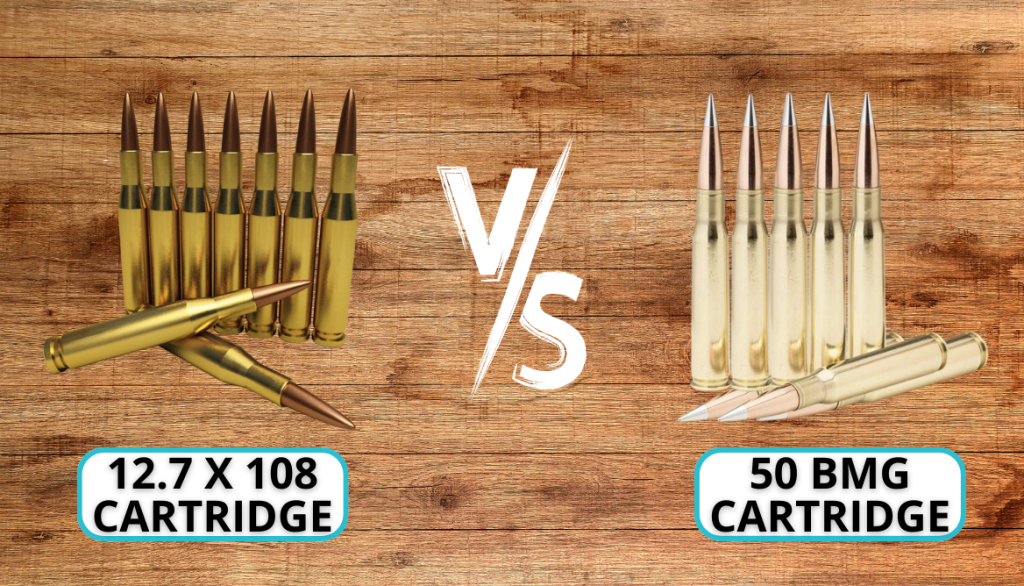
Are you confused between the mighty 12.7 x 108 vs 50 BMG ammunitions? In the world of high-caliber rifles, making the right choice can be crucial. Fortunately, we’re here to help you navigate the dilemma and make an informed decision.
Continue reading as we will take a deep dive into these calibers, looking at their effective ranges, and key differences. Let’s discover the details!
An Insight Into 12.7 x 108 vs 50 BMG
12.7 x 108 and .50 BMG are two formidable high-caliber ammunition options, each with its own unique characteristics. Let’s learn about them!
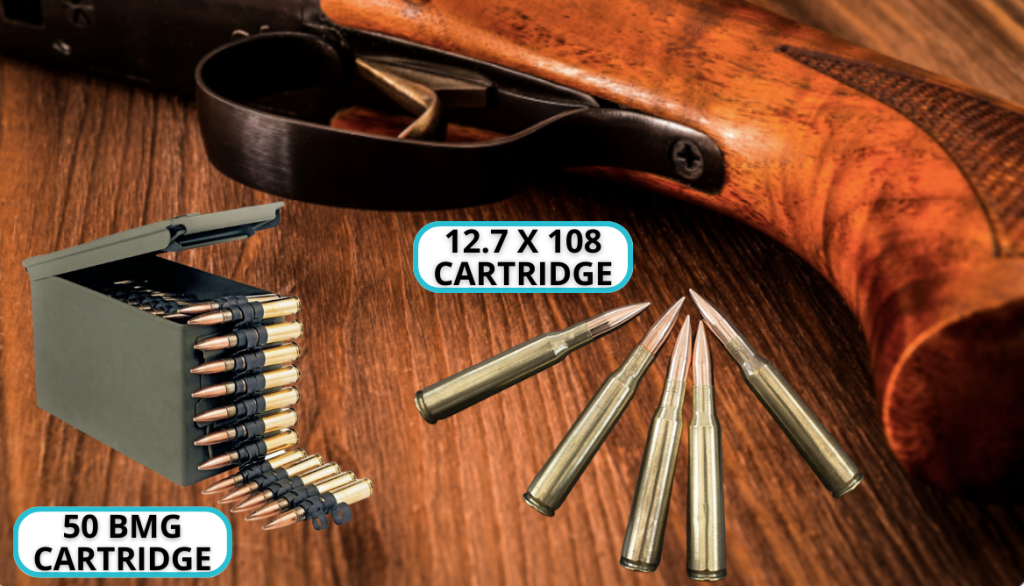
12.7 x 108
The 12.7 x 108 was originally developed in Russia. It is a common round used in high-caliber guns:
- Widely renowned for its power and penetration capabilities.
- It has a diameter of 12.7 mm and is commonly fired from weapons such as the NSV, DShK, and Kord machine guns.
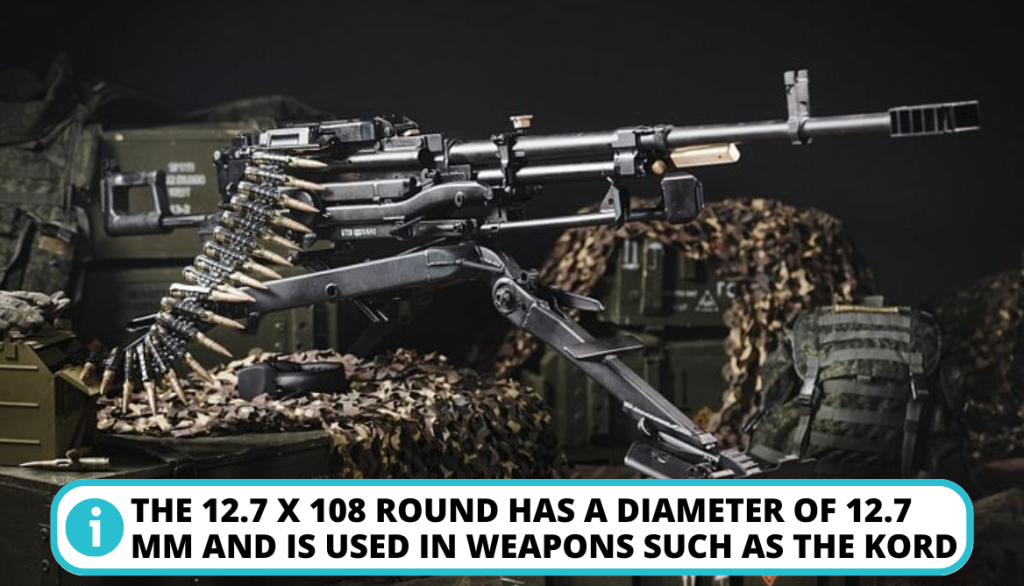
50 BMG
The .50 BMG is an American cartridge:
- It is famous for its exceptional long-range accuracy and stopping power.
- It boasts a diameter of .50 inches and is primarily used in heavy sniper rifles and machine guns.
Let’s now delve deeper into their key characteristics, effective ranges, and notable differences:

Distinguishing Between .50 Caliber and 12.7 mm: Understanding the Differences
.50 cal is not exactly the same caliber as 12.7 mm. Here is a comparative table highlighting the key specifications of 12.7 x 108 and 50 BMG ammunition:
Factor: | 12.7 x 108 | 50 BMG |
Diameter: | 12.7mm | .50 inches |
Origin: | Russia | United States |
Muzzle Velocity: | 770 to 923 m/s | 860 to 928 m/s |
Effective Range: | 2700 meters | 5600 meters |
Penetration Power: | High | High |
Typical Use: | Anti-material, Heavy Machine Guns | Long-Range Precision Shooting, Anti-Material, Heavy Machine Guns |
It’s important to note that there is a slight difference in bullet shape. But still, both cartridges are considered extremely powerful. With a high velocity, these are capable of delivering significant impact and penetration.
Meaning Behind .50 BMG
BMG stands for “Browning Machine Gun,” which pays homage to its creator, John Browning. The .50 BMG is a powerful cartridge primarily used in heavy machine guns and sniper rifles. We have covered the general specs of this caliber above. Here is some other info about this caliber:
- Penetration Power: Due to its length and velocity, the .50 BMG cartridge possesses impressive penetration power. It is capable of entering various barriers and materials.
- Military and Civilian Use: It was initially designed for military use in heavy machine guns. But the .50 BMG has also found its place among civilian shooters and is utilized in long-range shooting competitions.
- Ammunition Variants: The .50 BMG ammunition comes in various types, including full metal jackets, armor-piercing, incendiary, and tracer rounds.
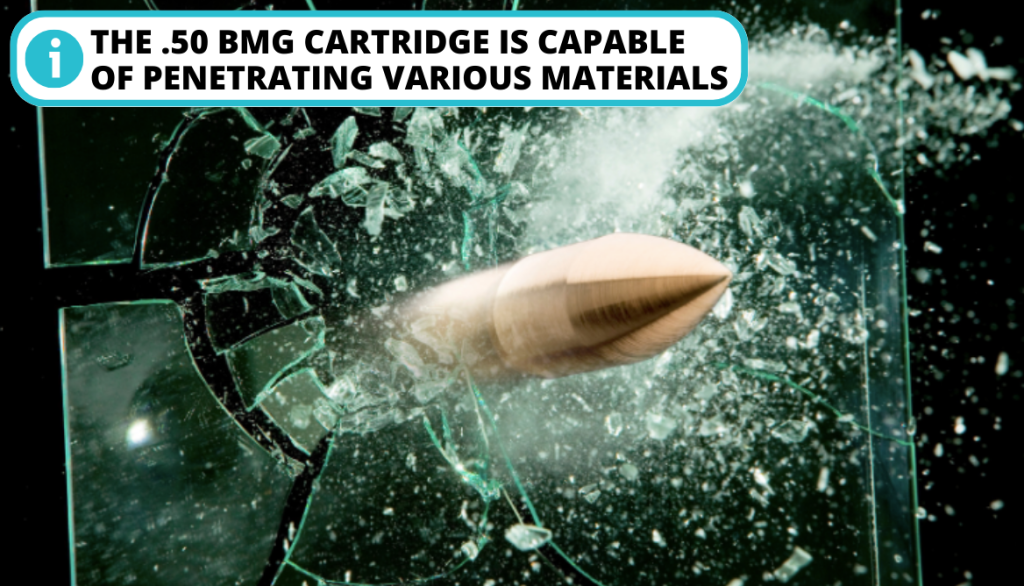
Compatibility Check: Firing .50 BMG from a 12 Gauge Shotgun
One question that frequently arises is whether it is possible to fire a .50 BMG round from a 12 gauge shotgun. The answer is a definitive no. The reason behind this lies in the disparity between the sizes of the cartridges.
Diameter Change
The .50 BMG bullet shape is too large to fit into the chamber of a 12 gauge shotgun. Attempting to do so would be ill-advised and potentially dangerous.
If you have come across any videos online, then you shouldn’t attempt to recreate them. It can be fatal if something goes wrong.
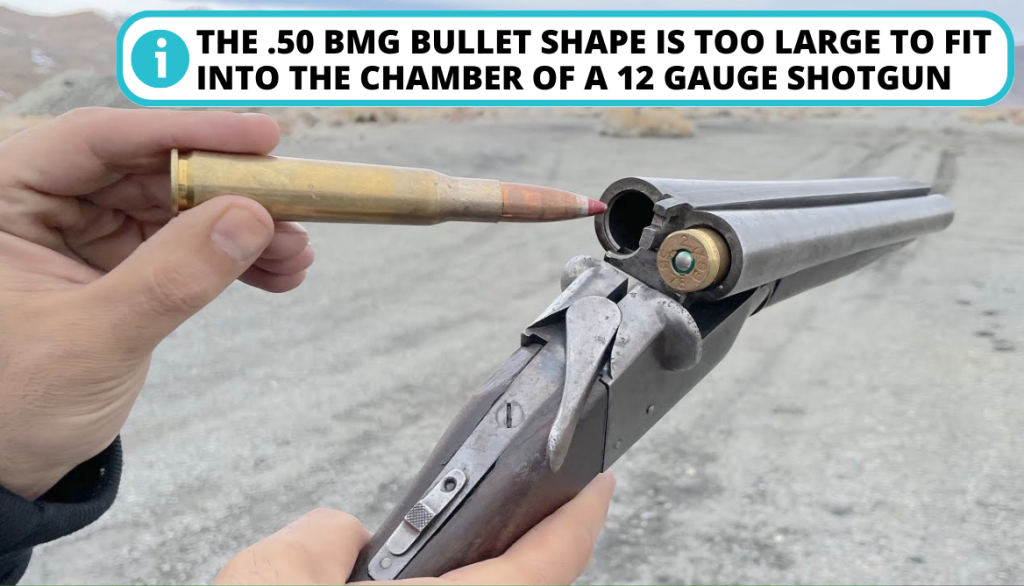
Firearms Chambered in .50 Caliber
The .50 caliber ammunition is utilized in various firearms. Each one of them is designed to harness the power and capabilities of this formidable cartridge. Some prominent examples of firearms that can shoot .50 caliber include:
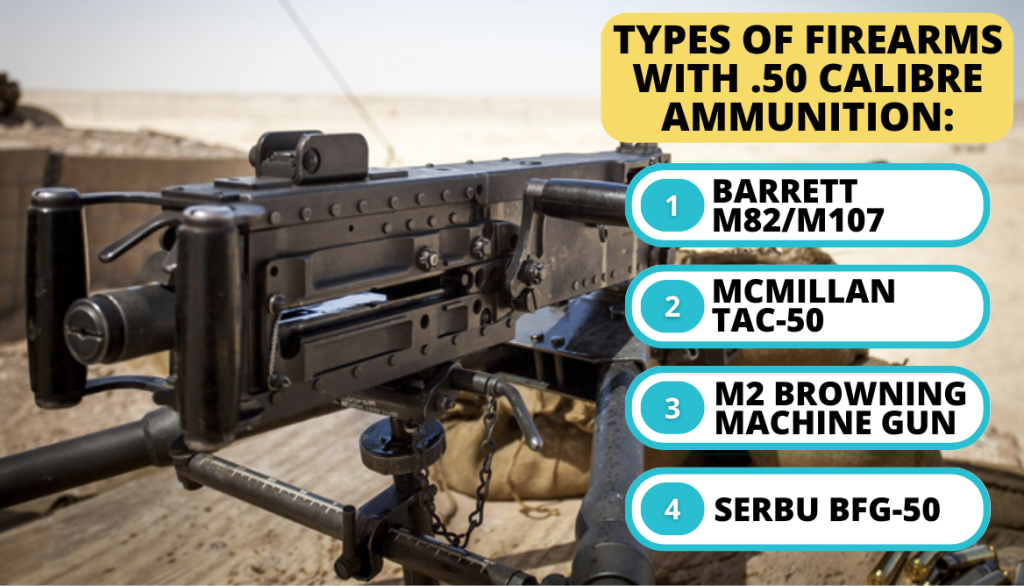
- Barrett M82/M107: Well-known anti-materiel rifles that are chambered in .50 BMG. These are famous for their long-range accuracy and penetration power.
- McMillan TAC-50: This is a bolt-action sniper rifle chambered in .50 BMG. This weapon is designed for precision shooting at extreme distances.
- M2 Browning Machine Gun: The legendary M2 is a machine gun that is often mounted on military vehicles, aircraft, and naval vessels. It is also chambered in .50 BMG. It is celebrated for its reliability, firepower, and versatility.
- Serbu BFG-50: This is a semi-automatic weapon chambered in .50 BMG and designed for civilian use. It offers long-range shooting capabilities for sports shooting.
It’s important to note that cartridges are not interchangeable. It is due to slight differences in dimensions and ballistics. The firearms listed above are specifically designed to handle .50 caliber ammunition and should not be used with 12.7x108mm ones.
Understanding the 12.7mm Firearms
The 12.7 mm gun refers to firearms that utilize 12.7×108 mm ammunition. It is known for its potency and versatility. This ammunition is commonly used in heavy machine guns and anti-materiel rifles.
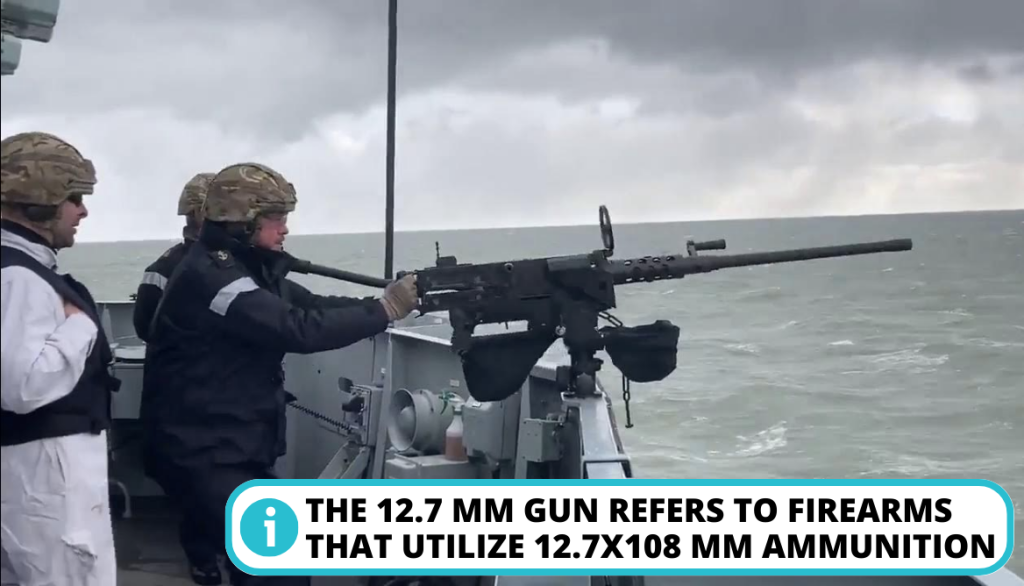
Firearms That Use This Cartridge
The 12.7×108 mm cartridge is a formidable round that offers substantial power and penetration capabilities. It is used in the following types of weapons:
1. Machine Guns
It is frequently employed in heavy machine guns such as:
- NSV,
- DShK,
- Kord.
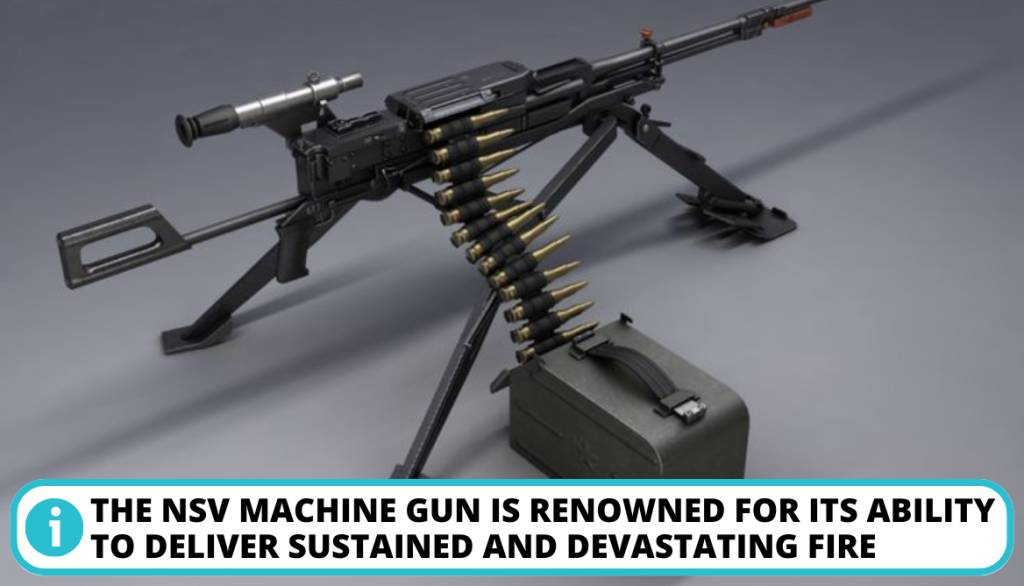
These are known for their ability to deliver sustained and devastating firepower. These machine guns are utilized in various military applications, including defense against ground targets, suppression, and vehicle engagement.
2. Anti-Material Rifles
It is also compatible with anti-materiel rifles. Designed for engaging and neutralizing high-value targets such as armored vehicles, structures, and equipment.
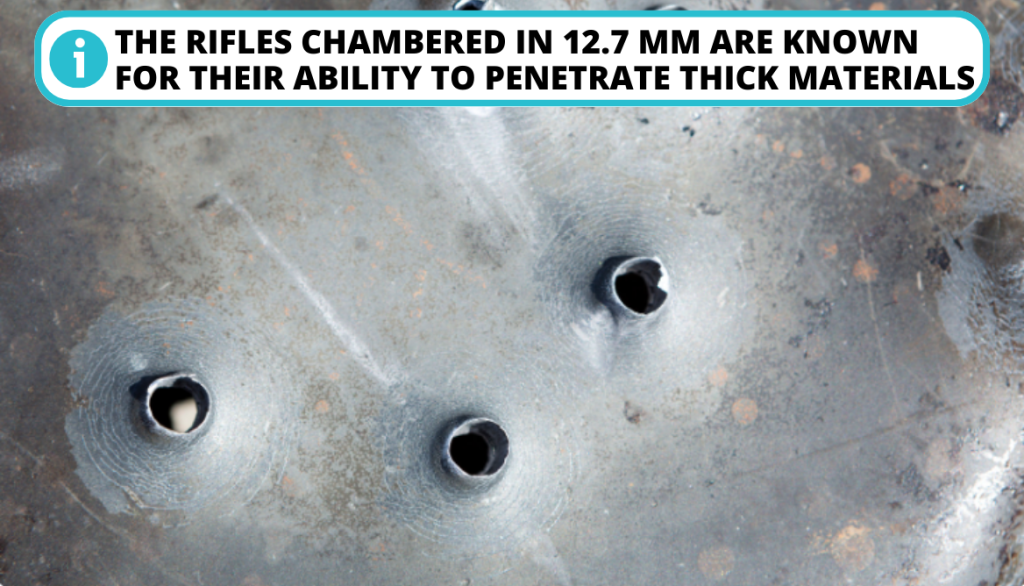
The rifles chambered in 12.7 mm are known for their ability to penetrate thick materials. Examples of anti-materiel rifles chambered in 12.7 mm include:
- OSV-96,
- KSVK.
It’s worth noting that the 12.7 mm caliber is not limited to these specific firearms. A lot of variations may exist based on different manufacturers and regions. The cartridge’s dimensions and ballistics remain consistent, ensuring interchangeability among compatible weapons.
Size of 50 Caliber Rifles: Bullet Shape & Size!
The .50 caliber rifles are renowned for their substantial bullet shape and robustness. While it might seem plausible to make them more compact, several factors contribute to their current dimensions.

Let’s examine the reasons behind the size of .50 caliber weapons:
- Cartridge Dimensions: The .50 BMG cartridge itself is large and powerful. It measures 50 inches in diameter. The cartridge’s dimensions require a corresponding chamber size in the rifle.
- Ballistic Performance: It is designed for long-range shooting and anti-materiel applications. It requires a firearm with sufficiently long barrel to achieve optimal ballistic performance. Longer barrels provide better muzzle velocity and accuracy which is essential for engaging targets at extended distances.
- Recoil Management: The substantial power of the .50 BMG cartridge generates significant recoil. To ensure shooter comfort, stability, and control, they often feature substantial weight and sturdy construction. The added size helps absorb and mitigate recoil, enhancing the shooting experience.
While it may be possible to explore more compact designs for .50 caliber weapons, there are inherent limitations to consider. Attempts to significantly reduce the size can:
- Compromise ballistic performance.
- Increase recoil.
- Impact shooter comfort and accuracy.
Exploring the Maximum Range of 12.7 mm Ammunition
The maximum range of the 12.7mm is about 2500 – 2800 meters. It has a fast muzzle velocity as well. So, the bullet will reach the indeed targets very quickly and accurately. It’s important to consider that different factors can affect the range such as:
- Environmental Conditions,
- Barrel Length,
- Projectile Weight,
- Shooter Skill.
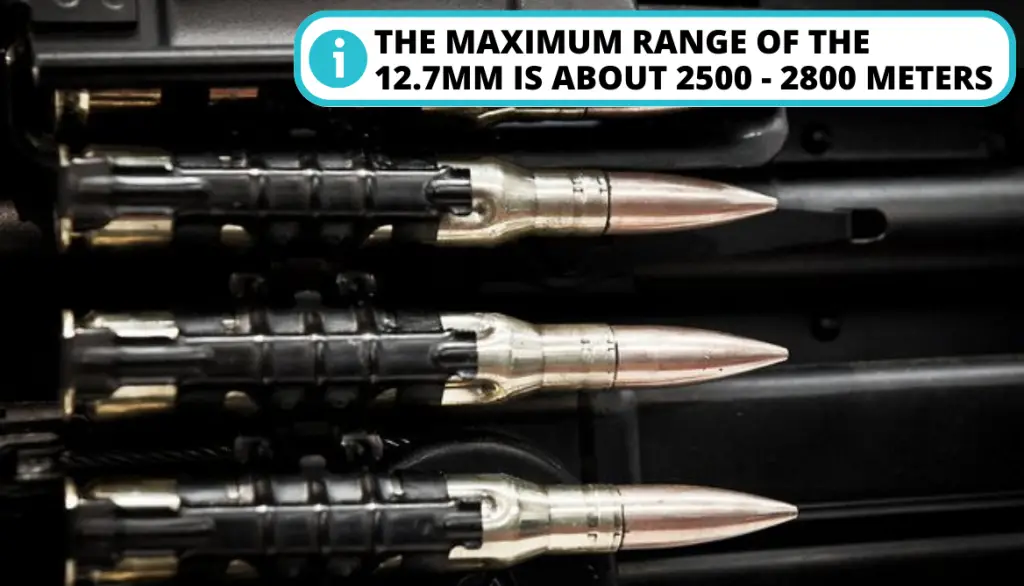
Distinguishing US and Russian Armor Piercing Rounds – Same Caliber?
When comparing the US .50 caliber armor piercing round and the Russian 12.7 mm armor piercing round, distinct differences are observed.
- The bullet designs also differ. The US .50 BMG typically features a full metal jacket with an armor-piercing (AP) core.
- The Russian 12.7 mm AP round often includes a steel core and a hardened steel or bimetal jacket.
.50 BMG | .50 Soviet |
= 12.7X99mm | = 12.7X109mm |
The Russian one provides a bit more damage but you still can’t ignore the 50 BMG. Both are quite excellent in their own regard.
12.7 x 108 vs 50 BMG – Which One Should You Choose?
The choice between the 12.7x108mm and 50 BMG calibers depends on individual preferences and specific requirements. But here are three compelling reasons for choosing each option:
Reasons to Choose 12.7x108mm
Listed below are the reasons you should opt for 12.7:
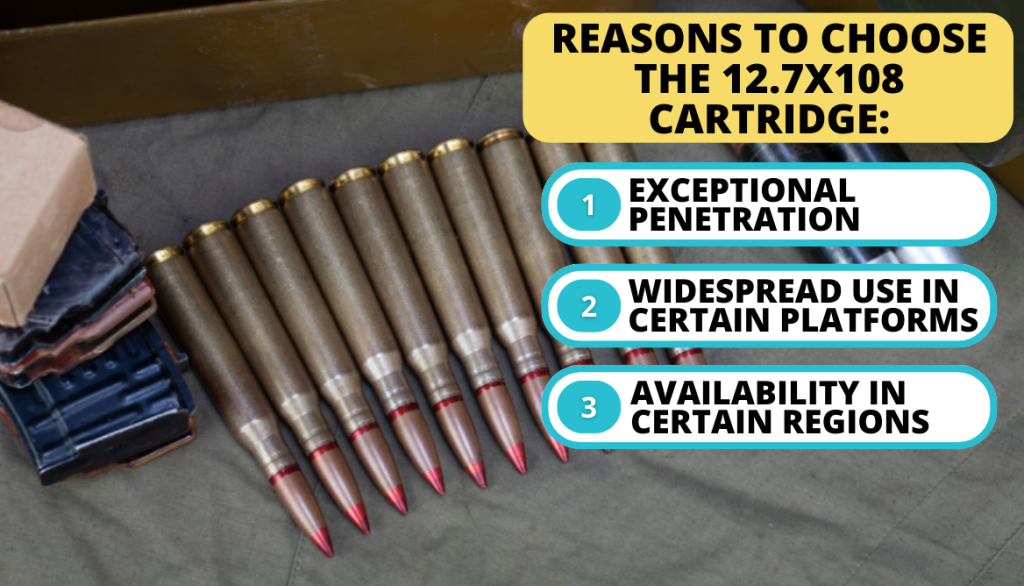
- Exceptional Penetration: The 12.7x108mm cartridge has higher muzzle velocity and powerful bullet design, and offers outstanding penetration capabilities. It excels in anti-materiel applications. So, this makes it a preferred choice when dealing with hardened targets or structures.
- Widespread Use in Certain Platforms: It is commonly utilized in various Russian and Soviet-designed firearms such as the NSV, DShK, and Kord machine guns. If you have a particular preference for these platforms or have access to them, the 12.7x108mm would be a suitable choice.
- Availability in Certain Regions: Depending on your location, the 12.7x108mm ammunition may be more readily available compared to .50 BMG. If access to a consistent supply of ammunition is a crucial factor, opting for the 12.7x108mm could be advantageous.
Reasons to Choose 50 BMG
Here’s why you should choose this ammo:
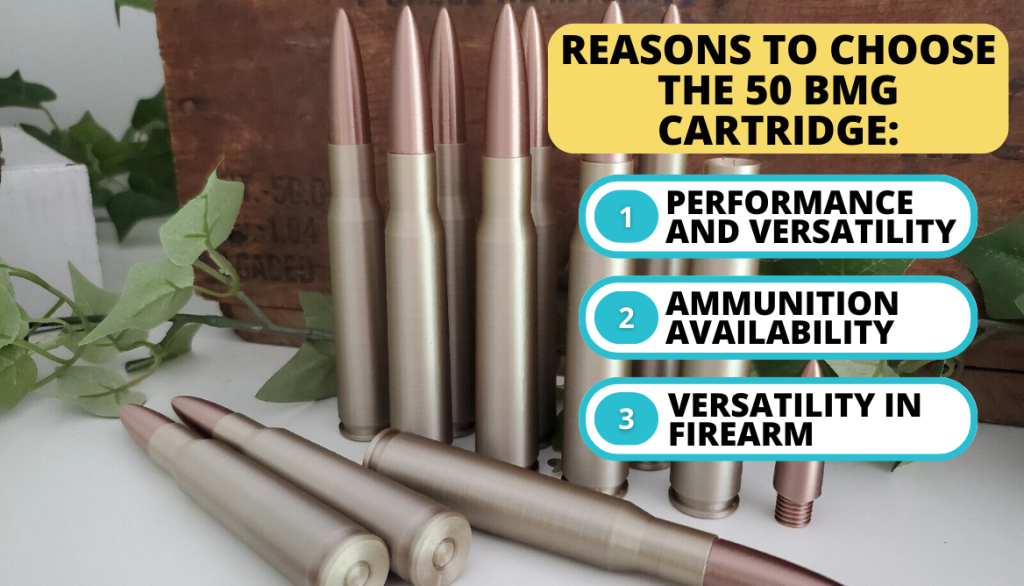
- Proven Performance and Versatility: The .50 BMG has a long history of successful deployment in various military, law enforcement, and civilian applications.
- Extensive Ammunition Availability: This ammunition enjoys broad availability globally, making it easier to acquire compared to more specialized or region-specific calibers.
- Versatility in Firearm Options: It is chambered in a wide range of firearms, including rifles, machine guns, and anti-materiel rifles.
Evaluating these reasons can help guide your selection and ensure the optimal choice for your shooting endeavors.
FAQ
Is 12.7108 a 50 BMG?
No, 12.7×108 is not the same as .50 BMG. They are two different calibers with distinct specifications and dimensions.
What can stop a 50-cal bullet?
Materials like thick concrete walls, armored vehicles, and heavy steel plates are capable of stopping a .50 caliber bullet. The bullet will lose all of its momentum when passing through these materials.
Is the 50 BMG better than the 12.7×99?
The comparison between the .50 BMG and 12.7x99mm depends on specific factors. Each caliber has its own strengths and applications, so determining which is better would depend on a person’s requirements.
How strong is a 50 BMG bullet?
50 BMG is a really strong bullet. It has a lot of kinetic energy and can penetrate into a lot of objects quite easily.
Conclusion
Both ammunitions are really powerful but are made for different people. While the Soviet one showcases impressive power and range, the .50 BMG stands out with its widespread use, proven performance, and extensive availability.
Both deliver excellent performance but in the end, it boils down to your personal preference. Go with the one that is more suitable to your needs.
Which of these high-caliber ammunition options would you choose for your shooting endeavors? Let us know in the comments!
